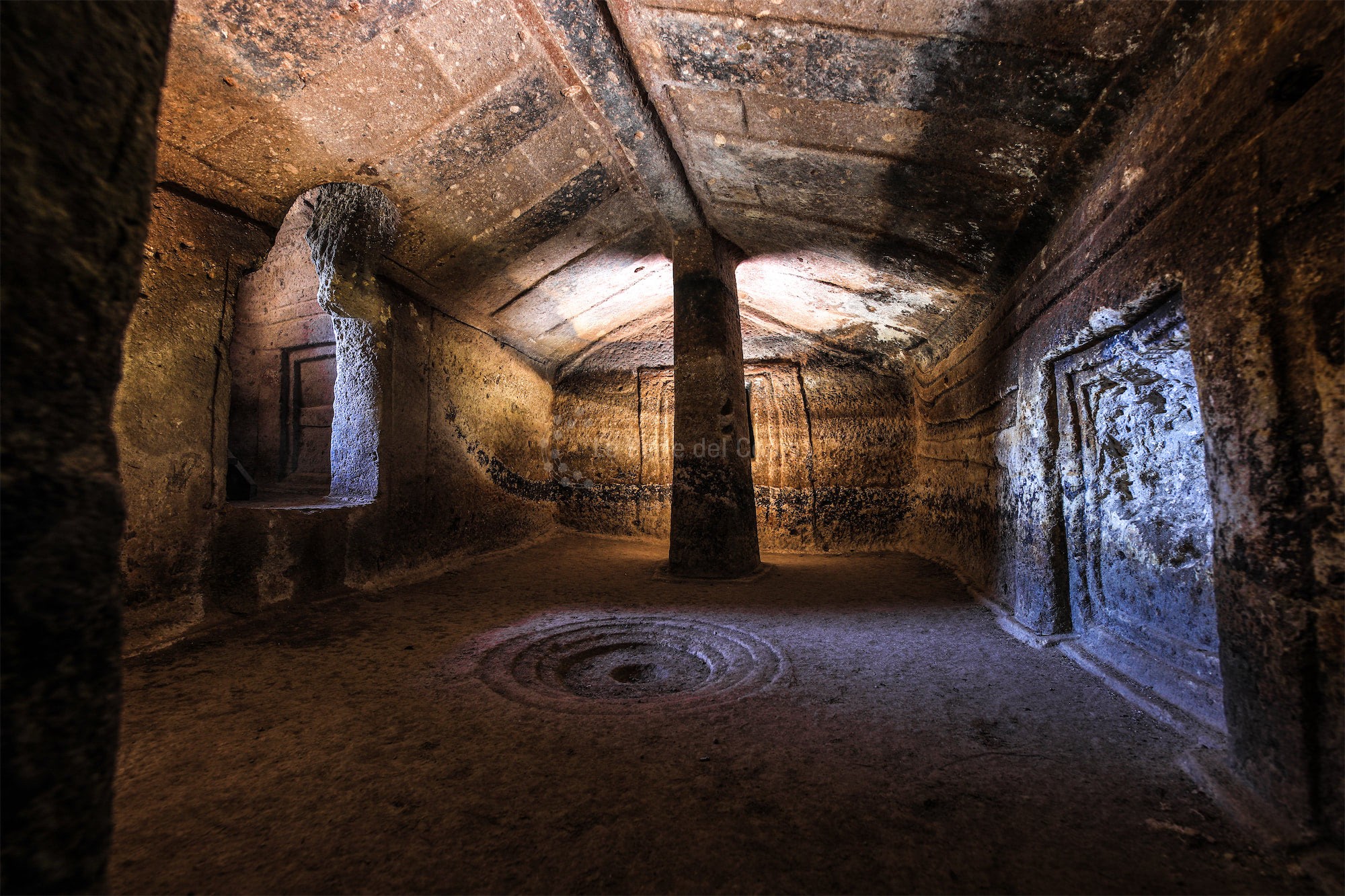
Putifigari
Domus de janas S’Incantu
The Pre-nuragic sepulchre of Putifigari is located in the Valley of S’Incantu (tn* Sardinian prehistory dating back from 4000 to 3000 BC). It is the most famous example of Neolithic painted architecture. The domus de janas S’Incantu were excavated into a semi-circle of pink tuff, along the slopes of Mount Siseri, 850 metres above sea level. The domus called “S’Incantu”, meaning “Wonder”, was brought to light in 1989 and dates back to the Late Neolithic-Eneolithic Age (3200-2600). This ancient tomb represents a marvellous example of domus de janas made five thousand years ago. It is a single sepulchral monument, perhaps the most famous and intact funerary work of art from the past that still remains in modern times in all its magnificence. A beacon for the civilisations of the Mediterranean that illuminates the territory of Coros, and the beginning of a unique touristic itinerary. Perfectly sculpted in rock, “S’Incantu” represents a Neolithic hut that accompanies the human being in their journey from life to death. It is a place where the dead have rested in peace for centuries. No detail has been left to chance, such as the bas-reliefs. Inside there is an architectural work without equal, a variety of decorations and colours, an attention to meaning and symbols that unites this worldly life to the one beyond. Moreover, by representing the home in the afterlife exactly the same way as the worldly home, the domus S’Incantu gives us an extraordinary example not only of funerary architecture, but also of civil architecture, duplicating in every minute detail a Late Neolithic hut, with internal support poles, a roof truss, carved fake doors, and steps. Tomb I of the sepulchre is accessible, where refined sculptural details and bas-reliefs can be observed, but not only. The artistic effect in chiaroscuro (tn* light and dark contrast) magically enriches the monument, comparable in magnificence to Etruscan chamber tombs. The T-shaped plan includes adjoining rooms, with different floor elevations and a long dromos (tn* corridor) that ends with a decorated atrium. Entering the domus, there is a small quadrangular antechamber, where triple “boat-shaped” curved bull horns are carved, along with two doors on the side walls, symbolising the passage to the afterlife. The main chamber is opposite the entrance. It is rectangular with a two-metre high roof and a form quite close to perfection. An example of architectural ability without equal: it has a double pitched wooden roof carved in relief. The alternation of different chromatic shades completes the masterpiece: the central beam and the seven transversal ones are painted black, while the lateral beams and the spaces in between are painted with red ochre. The roof seems to be supported by two square columns, made by removing the rock, with stylised bullhorn-shaped protomes (tn* a protome is a type of figure adornment with the head and upper torso of either a human or an animal). Also, the opposite wall has a fake door framed by triple bullhorns. The devotion to the Bull god here is tangible, as a symbol of fertility it was the basis of Pre-nuragic religion. On the sides, two decorated elevated doors give access to the chambers designated for the burial of the dead. These chambers are bare, their simplicity in clear contrast with the decorations of the main chamber. On the outside of the hypogeum, along the rock formation, there are engraved cup marks, bowls and little ditches that prevented water from entering the tomb (tn* a cup mark consists of a concave depression, no more than a few centimetres across, pecked into a rock surface and often surrounded by concentric circles also etched into the stone). In the centre of the floor a hypnotic fireplace stands out: four concentric circles and a central cup mark, one metre in diameter, used to contain the offerings for the dead. Architectural perfection and devotion to the dead, S’Incantu represents the queen of domus de Janas in Sardinia, and captures the attention of thousands and thousands of visitors every year. The findings from the dig ascribe the tomb to the Culture of Ozieri, dating back to the Late Neolithic Age. This confirms the attribution of the curvilinear bull horns to this chronological and cultural time period, in contrast to other theories that so far, lacking archaeological dig data, have referred to these decorations as belonging to a later period, the Eneolithic, or Copper Age. (tn* the Culture of Ozieri was Pre-nuragic and spread throughout Sardinia from 4000 BC to 3300 BC. Its name comes from the locality where the vases were first found: the cave of San Michele in Ozieri, Northern Sardinia).
A few metres from Tomb I, are Tombs II and III. In the badde de janas (the valley of fairies), on the other side of the mountain and 700 metres from the other three, there is a fourth hypogeum, unfortunately damaged.
Source: “Alpine Prehistory” (in Italian) Museum of Science, Trento, 2012
- Domus de janas S’Incantu
- Water Fountain of Nadalinu
- Water Fountain of Solai
- Fountain of the Locality Pagliesu Fountain of the Locality Pagliesu
- Panorama from Torretta for the sighting of fires in the locality of Pagliaresu Panorama from Torretta for the sighting of fires in the locality of Pagliaresu
- Picnic area of Tuvu and Jolzi
- Domus de janas Su Prammittu Monte Murone
- Hut Park Gardens



